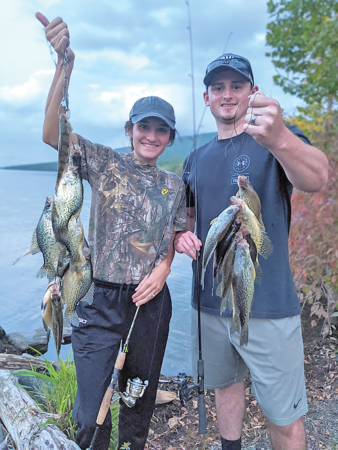I suppose it sounds a little bit odd to refer to a fishing outing for panfish as a “hunt,” but the bottom line is — you have to find out where the fish are before you can get on with the business of catching them.
That is exactly how the scenario played out last week when my wife and I invited my granddaughter, Sierra, and her husband, Tyler, to join us for a day on the lake. Our plans that day were to target panfish — that is, bluegills, crappies, and perch, and if all went well, maybe even bring some home for the dinner table.
Generally speaking, finding panfish in a lake is usually not a problem, especially in the spring and early summer. Catching good numbers, even for beginners, is often how things play out; however, that can be a different story come fall.
During the warm summer days, crappies and perch, and often even bluegills will spend their days in deeper water near the bottom or often times suspended somewhere in the water column. As the cooler fall weather begins to set in, crappies and perch begin to form tight schools and may show up almost anywhere in the lake, and if you don’t locate those schools, you will likely have trouble putting a bend in your rod.
However, you can still have some pretty fast fishing, but you may have to do some serious searching to find schools of willing feeders. Sure, you can pick up a fish or two just about anywhere, but if you are after serious numbers, don’t get too stationary.
There are a couple of ways to find feeding schools of fish, but the most proficient method is using a sonar unit or fish locater. I have one in the back of the boat and one up front where I operate the trolling motor; that way, I, and whoever is with me, will have immediate feedback as to what’s happening beneath the boat.
It was interesting this past week; as we drifted across the lake over various depths, we would often go for considerable distances with almost no activity showing up on the sonar, and then all of a sudden, we would find ourselves over a large, suspended school of fish. Sometimes when we hit the school, all four of us would suddenly have bends in our rods, but as soon as we passed the school or the school moved, the action stopped. The point is you can’t catch fish where there aren’t any fish
Now, if you don’t have sonar on your boat, all is not necessarily lost. Before I had sonar equipment and now even with sonar, I will sometimes prowl the lake for schools of fish simply by trolling. I usually troll at a slow speed with a jig/grub combination on an ultralight spinning rod with a four-pound test. It’s important to troll at different depths to help locate schools of fish — different weights of jigs or added weight will get you deeper if necessary. Once I, or someone else in the boat get a hit, I stop the trolling motor, and we all concentrate our efforts in the area where the strike occurred.
Most of our success this past week was in the water with 12-20-foot depths, but the fish were suspended at various depths. I often do much of my crappie and perch fishing with a white, plastic grub, and a one-eighth ounce or one-sixteenth ounce jig head, but because the water was a bit off-color, we found yellow and chartreuse to be better producers. I’m sure some type of live bait like minnows would have done well also, but the point is you have to be where the fish are in order to catch them.





Leave a Comment
Your email address will not be published. Required fields are marked with *